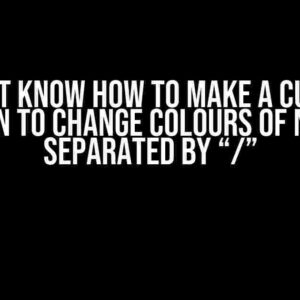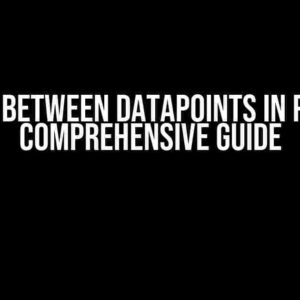Are you ready to unlock the secrets of computer vision and take your Node.js projects to the next level? Look no further! In this article, we’ll dive into the world of OpenCV, a powerful computer vision library, and explore how to integrate it with Node.js. Get ready to learn the ins and outs of image processing, object detection, and more!
What is OpenCV?
OpenCV (Open Source Computer Vision Library) is a free and open-source library of programming functions mainly aimed at real-time computer vision. It provides a vast range of features and tools for image and video processing, feature detection, object recognition, and more. OpenCV is widely used in various fields, including robotics, healthcare, surveillance, and even self-driving cars!
Why Use OpenCV with Node.js?
Node.js is a popular JavaScript runtime built on Chrome’s V8 JavaScript engine. It’s known for its speed, scalability, and ease of use. By combining OpenCV with Node.js, you can leverage the power of computer vision to build robust and efficient applications. Here are just a few reasons why you should consider using OpenCV with Node.js:
- Real-time image processing: OpenCV provides an extensive set of functions for image processing, allowing you to manipulate and analyze images in real-time.
- Object detection and recognition: OpenCV offers advanced object detection and recognition algorithms, enabling you to identify objects, faces, and patterns in images and videos.
- Video analysis: OpenCV provides tools for video analysis, including motion detection, object tracking, and scene understanding.
- Machine learning: OpenCV integrates well with machine learning libraries, allowing you to build predictive models and classify images.
Setting Up OpenCV with Node.js
To get started with OpenCV and Node.js, you’ll need to install the required dependencies. Follow these steps:
- Install Node.js: Download and install Node.js from the official website if you haven’t already.
- Install OpenCV: You can install OpenCV using npm (Node Package Manager) by running the following command:
npm install opencv. - Install the opencv4nodejs module: This module provides a Node.js wrapper for OpenCV. Install it using npm:
npm install opencv4nodejs.
Importing OpenCV in Node.js
Once you’ve installed the required dependencies, you can import OpenCV in your Node.js code using the following line:
const cv = require('opencv4nodejs');This line imports the OpenCV module and assigns it to the cv variable.
Basic Image Processing with OpenCV and Node.js
Now that you’ve set up OpenCV with Node.js, let’s dive into some basic image processing examples:
Reading an Image
To read an image using OpenCV, use the following code:
const img = cv.imread('image.jpg');This code reads an image file named “image.jpg” and assigns it to the img variable.
Displaying an Image
To display an image using OpenCV, use the following code:
cv.imshow('Image', img);
cv.waitKey(0);
cv.destroyAllWindows();This code displays the image in a window with the title “Image”, waits for a key press, and then closes the window.
Image Filtering
OpenCV provides various image filtering functions. Here’s an example of applying a Gaussian blur filter:
const blurImg = new cv.Mat();
cv.GaussianBlur(img, blurImg, new cv.Size(5, 5), 0);
cv.imshow('Blur', blurImg);This code applies a Gaussian blur filter to the original image and displays the resulting image.
Object Detection with OpenCV and Node.js
Object detection is a fundamental task in computer vision. OpenCV provides several algorithms for object detection, including Haar cascades and Deep Learning-based approaches. Here’s an example of using Haar cascades for face detection:
const faceCascade = new cv.CascadeClassifier(cv.haarcascades + 'haarcascade_frontalface_default.xml');
const faces = faceCascade.detectMultiScale(img);
console.log(`Found ${faces.size()} faces.`);This code loads a Haar cascade classifier for face detection, detects faces in the image, and logs the number of detected faces to the console.
Video Analysis with OpenCV and Node.js
OpenCV provides various functions for video analysis, including video capture, video writing, and video processing. Here’s an example of capturing video from a camera and detecting motion:
const video = new cv.VideoCapture(0);
let frame;
while (true) {
frame = video.read();
if (frame.empty) {
break;
}
const gray = cv.cvtColor(frame, cv.COLOR_BGR2GRAY);
const blur = cv.GaussianBlur(gray, new cv.Size(5, 5), 0);
const thresh = cv.threshold(blur, 25, 255, cv.THRESH_BINARY)[1];
const contours = cv.findContours(thresh, cv.RETR_EXTERNAL, cv.CHAIN_APPROX_SIMPLE);
for (const contour of contours) {
const area = cv.contourArea(contour);
if (area > 100) {
console.log('Motion detected!');
}
}
}This code captures video from the default camera, converts each frame to grayscale, applies a Gaussian blur filter, and detects motion using contour detection.
Machine Learning with OpenCV and Node.js
OpenCV provides interfaces to various machine learning libraries, including TensorFlow and Scikit-learn. Here’s an example of using OpenCV with TensorFlow for image classification:
const tf = require('@tensorflow/tfjs');
const model = tf.sequential();
model.add(tf.layers.conv2d({ inputShape: [28, 28, 1], filters: 32, kernelSize: 3, activation: 'relu' }));
model.add(tf.layers.flatten());
model.add(tf.layers.dense({ units: 10, activation: 'softmax' }));
model.compile({ optimizer: tf.optimizers.adam(), loss: 'categoricalCrossentropy', metrics: ['accuracy'] });
const img = cv.imread('image.jpg');
const tensor = tf.tensor3d(img.data, [1, 28, 28, 1]);
const prediction = model.predict(tensor);
console.log(`Prediction: ${prediction}`);This code creates a simple convolutional neural network using TensorFlow, loads an image using OpenCV, and uses the model to classify the image.
Conclusion
In this article, we’ve explored the world of OpenCV and Node.js, covering the basics of image processing, object detection, video analysis, and machine learning. With OpenCV and Node.js, the possibilities are endless! Whether you’re building a real-time object detection system, a video analysis platform, or a machine learning model, OpenCV and Node.js provide the tools and libraries you need to succeed.
So, what are you waiting for? Start building your next computer vision project with OpenCV and Node.js today!
| Function | Description |
|---|---|
cv.imread() |
Reads an image file |
cv.imshow() |
Displays an image in a window |
cv.GaussianBlur() |
Applies a Gaussian blur filter to an image |
cv.CascadeClassifier() |
Loads a Haar cascade classifier for object detection |
cv.VideoCapture() |
Captures video from a camera |
cv.contours() |
Finds contours in an image |
This article has demonstrated the power and flexibility of using OpenCV with Node.js. With these tools, you can unlock the secrets of computer vision and take your projects to the next level. Happy coding!
Recommended Resources
Want to learn more about OpenCV and Node.js? Check out these recommended resources:
- OpenCV Official Documentation
- Frequently Asked Questions
Get ready to unlock the power of computer vision with OpenCV and Node.js! Below, we’ve got the answers to your most burning questions.
What is OpenCV and how does it relate to Node.js?
OpenCV (Open Source Computer Vision Library) is a powerful library for computer vision and machine learning. It provides a vast range of functionalities for image and video processing, feature detection, object recognition, and more. By using OpenCV with Node.js, you can leverage the power of computer vision in your web applications, allowing you to build innovative projects such as object detection, facial recognition, and image processing.
How do I install OpenCV with Node.js?
Installing OpenCV with Node.js is a breeze! You can use the npm package manager to install the `opencv` package by running `npm install opencv`. Alternatively, you can install OpenCV globally on your system and then use a Node.js wrapper like `opencv-js` to interact with the library.
Can I use OpenCV with Node.js for real-time video processing?
Absolutely! OpenCV with Node.js is perfect for real-time video processing applications. You can use the `opencv` package to capture video frames from a camera or video file, and then apply various computer vision techniques to process the frames in real-time. This allows you to build projects such as object tracking, facial recognition, and motion detection.
How do I optimize OpenCV performance with Node.js?
To optimize OpenCV performance with Node.js, make sure to use the latest version of OpenCV and Node.js. You can also use techniques such as multi-threading, parallel processing, and GPU acceleration to speed up your applications. Additionally, consider using optimized algorithms and data structures to reduce computation time and memory usage.
Are there any examples or tutorials available for using OpenCV with Node.js?
Yes! There are numerous examples and tutorials available online that demonstrate the use of OpenCV with Node.js. You can find tutorials on platforms such as YouTube, GitHub, and Udemy, as well as blogs and forums dedicated to computer vision and machine learning. These resources can help you get started with building your own projects and applications using OpenCV and Node.js.



